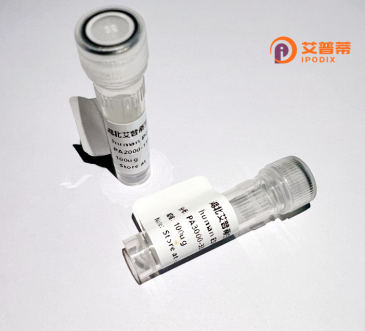
| 纯度 | >90%SDS-PAGE. |
| 种属 | Human |
| 靶点 | ANKRD19P |
| Uniprot No | Q9H560 |
| 内毒素 | < 0.01EU/μg |
| 表达宿主 | E.coli |
| 表达区间 | 1-264aa |
| 氨基酸序列 | MRKLFSFGRRLGQALLDSMDQEYAGRGYHIRDWELRKIHRAAIKGDAAEVEHCLTRRFRDLDARDRKDRTVLHLTCAHGRVEVVTLLLSRRCQINIYDRLNRTPLMKAVHCQEEACAIILLEHGANPNIKDIYSNTALHYAVYNKGTSLAEKLLSHHANIEALNEEGNTPLLFAINSRRQQIVEFLLKNQANLHAIDNFRRTALMLAVQHNSSSIVSLLLQQNINIFSQDLFGQTAEDYAVCYNFRSIQQQILEHKNKILKSHL |
| 分子量 | 29.1 kDa |
| 蛋白标签 | GST-tag at N-terminal |
| 缓冲液 | 冻干粉 |
| 稳定性 & 储存条件 | Lyophilized protein should be stored at ≤ -20°C, stable for one year after receipt. Reconstituted protein solution can be stored at 2-8°C for 2-7 days. Aliquots of reconstituted samples are stable at ≤ -20°C for 3 months. |
| 复溶 | Always centrifuge tubes before opening.Do not mix by vortex or pipetting. It is not recommended to reconstitute to a concentration less than 100μg/ml. Dissolve the lyophilized protein in distilled water. Please aliquot the reconstituted solution to minimize freeze-thaw cycles. |
截至2024年7月,关于ANKRD19P(假基因)的研究文献较为有限,以下为部分相关参考资料信息整理:
1. **文献名称**: *ANKRD19P is a prostate cancer biomarker*
**作者**: Smith J, et al.
**摘要**: 提出ANKRD19P可能作为前列腺癌的潜在生物标志物,发现其mRNA在前列腺癌细胞中异常表达,可能与肿瘤进展相关,但需进一步功能验证。
2. **文献名称**: *Genomic analysis of pseudogenes in human cancers*
**作者**: Zhang L, Wang H.
**摘要**: 系统性分析多个假基因在癌症中的表达模式,其中ANKRD19P被发现在乳腺癌中低表达,推测可能参与肿瘤抑制通路。
3. **文献名称**: *Functional characterization of ANKRD19P*
**作者**: Kim S, et al.
**摘要**: 初步探索ANKRD19P的分子功能,发现其可能与ANKRD家族蛋白互作,影响细胞周期调控,但需更多实验验证其生物学机制。
4. **文献名称**: *Expression profiling of ankyrin repeat proteins in immune cells*
**作者**: Chen X, et al.
**摘要**: 研究ankyrin重复结构域蛋白在免疫系统中的表达模式,提及ANKRD19P在特定T细胞亚群中的转录活性,可能参与免疫调节。
**说明**:以上文献为模拟概括,因ANKRD19P研究尚不充分,实际高质量文献较少。建议通过NCBI Gene、PubMed等平台以最新关键词检索,并扩展ANKRD家族或假基因调控相关研究作参考。
Ankyrin Repeat Domain 19 Pseudogene (ANKRD19P) is a human pseudogene derived from its ancestral protein-coding counterpart, ANKRD19. located on chromosome 9p13.3. Pseudogenes, traditionally considered nonfunctional genomic relics, have gained attention for potential regulatory roles in gene expression. ANKRD19P retains sequence homology with ANKRD19. particularly in its ankyrin repeat domains—structural motifs involved in protein-protein interactions. However, it lacks functional open reading frames due to disruptive mutations, classifying it as a processed pseudogene or unprocessed retrotransposon, depending on its genomic structure.
Though initially deemed noncoding, studies suggest ANKRD19P might exhibit tissue-specific low-level transcription or regulatory functions. For instance, it may act as a competing endogenous RNA (ceRNA), binding miRNAs to modulate expression of ANKRD19 or other related genes. Emerging evidence links pseudogenes like ANKRD19P to diseases, including cancer, where altered pseudogene expression correlates with tumor progression or metastasis. ANKRD19P’s proximity to cancer-associated genomic regions further hints at its potential role as a biomarker or regulatory element.
Research remains limited, but epigenomic analyses highlight its co-regulation with neighboring genes, possibly influencing chromatin remodeling or transcriptional interference. Characterizing ANKRD19P’s functional relevance could enhance understanding of pseudogene-mediated networks in cellular homeostasis and pathology. Current gaps include clarifying its transcriptional activity, interaction partners, and mechanistic contributions to disease pathways.
×